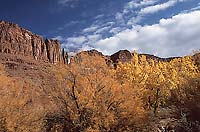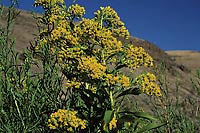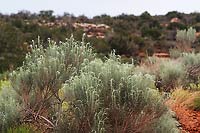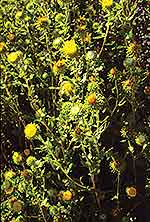 Overlooked most of the year, several shrubs that grow in the Southwest really hit their stride in September. Whereas many flowering shrubs bloom during the spring and summer, attracting bees and wasps and butterflies as pollinators, a contingent of late-summer bloomers erupt with subtle flowers that rely upon the wind or insects to pollinate their blooms.
Overlooked most of the year, several shrubs that grow in the Southwest really hit their stride in September. Whereas many flowering shrubs bloom during the spring and summer, attracting bees and wasps and butterflies as pollinators, a contingent of late-summer bloomers erupt with subtle flowers that rely upon the wind or insects to pollinate their blooms.
Because these shrubs either grow in profusion or dominate the landscape, their late summer contribution to an already colorful landscape is hard to miss. The golden yellow flowers of rabbitbrush and snakeweed blend in with the more subtle colors of sagebrush and greasewood. But these flowering shrubs mark the end of summer, even though they may continue to bloom into the fall.
 Rabbitbrush, also known as chamisa, grows in a range of poor soil types and varies in stature from low to high. Matted with fine hairs along the stems, the dense shrubs provide an umbrella of coverage to small mammals, rabbits included, that seek shelter beneath their branches; hence, the common name. These stems were harvested and drained of their milky latex which to make rubber, but you can imagine that cost outweighed production in the end. More economical is the manufacturing of a natural golden dye from the flowers that was once used by Native Americans and is still used by modern-day weavers to dye yarn or wool.
Rabbitbrush, also known as chamisa, grows in a range of poor soil types and varies in stature from low to high. Matted with fine hairs along the stems, the dense shrubs provide an umbrella of coverage to small mammals, rabbits included, that seek shelter beneath their branches; hence, the common name. These stems were harvested and drained of their milky latex which to make rubber, but you can imagine that cost outweighed production in the end. More economical is the manufacturing of a natural golden dye from the flowers that was once used by Native Americans and is still used by modern-day weavers to dye yarn or wool.
Rabbitbrush produce an abundance of tiny seeds topped with fine, thin white hairs that aid in dispersal. Like many members of the Sunflower family these hairs act like a parachute, catching the wind and keeping the seeds aloft and, ideally, away from the parent plant. Rabbitbrush, like their distant cousin snakeweed, do well in disturbed soils and are sometimes used in xeriscape gardens due to their hardiness. 
Smaller in size than rabbitbrush, snakeweed is another Sunflower family member that often blooms in great profusion in late summer. With long thin stems and small flowers, these plants are indicators of disturbed land. They do well where other native plants fail; their hardiness in overgrazed areas tends to give them a “weedy” character, although their adaptability is to be applauded.
Another shrub that sometimes lacks respect is big sage or sagebrush. The ragged stems with peeling bark and lack of appeal as a forage plant relegate this shrub to an unwanted status. Though cattle and livestock may turn their noses up at the bitter leaves, mule deer move into sagebrush-steppe habitat in winter and there are numerous bird species, like the Gunnison s age-grouse that depend entirely upon intact sagebrush ecosystems throughout their life cycles as both a forage plant and one that provides cover for nest sites in spring.
age-grouse that depend entirely upon intact sagebrush ecosystems throughout their life cycles as both a forage plant and one that provides cover for nest sites in spring.
In contrast to the big sage, sand sage or old man sage has a “soft” appearance due to its slender leaves and long flowering wands. Growing mostly in sandy soils, this sage produces a lovely fragrance, like its bigger cousin, after a summer storm.
Besides the shrubs, there are several forbs that contribute color to the late summer landscape. Gumweed and prairie sunflowers, sacred datura and dogbane, goldenrod and evening primroses produce colorful flowers in the waning months of summer. If conditions are just right, especially after some heavy summer rainfall, plants like cliffrose will enter into a second blooming period taking advantage of the moisture.
So don’t fret if you missed the spring season with its profusion of desert wildflowers. Late summer and autumn can be colorful also; you just have to concentrate on the shrubs that are the main contributors of color to this already colorful landscape.